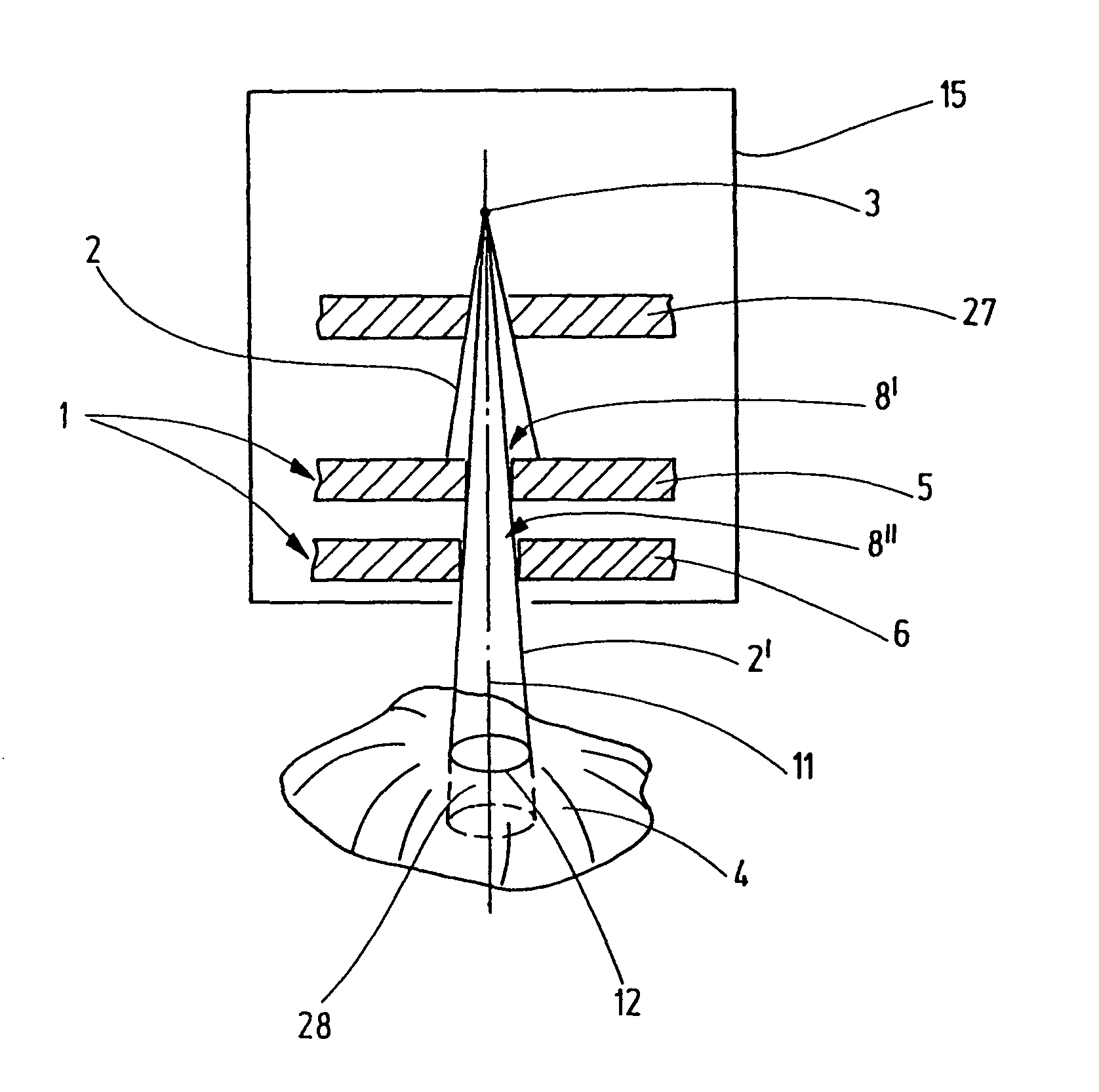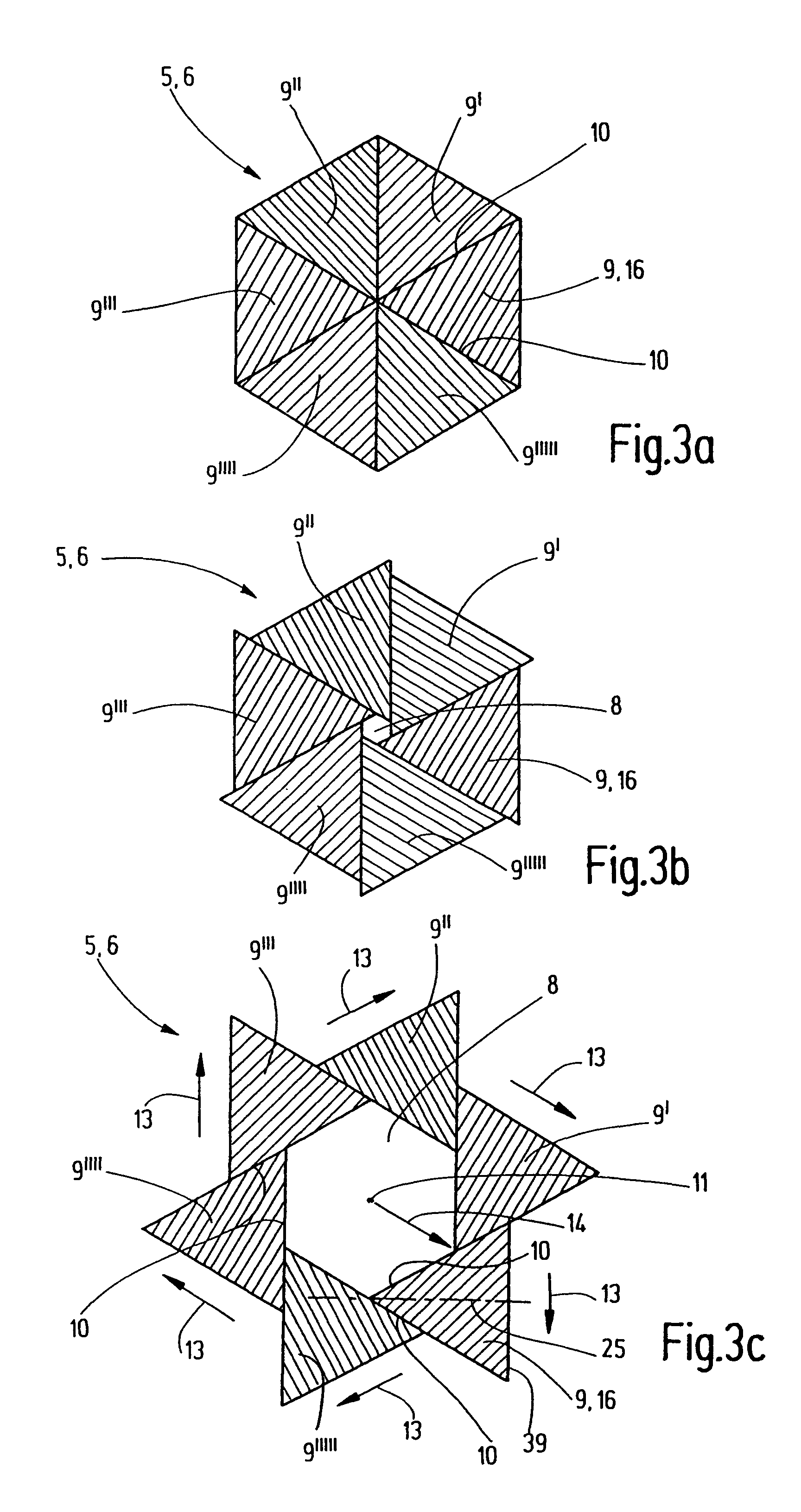Since in most cases the tumors or other areas to be diagnosed are round in shape, the imaging field should be circular as well and, of course, it should not exceed the area of interest to the doctor, as X-rays are also harmful to the tissue.
Consequently, this radiation would also destroy the surrounding tissue.
Only high-energy
therapeutic radiation—as required, for example, for the destruction of
tumor tissue—will cause damage to
healthy tissue in the over-range irradiation area, i.e. outside the
tumor tissue to be irradiated, since radiation must be applied at a certain intensity and over a certain period of time required to destroy the tumor issue.
These over-range irradiation areas were caused by missing or insufficient imaging of the contour of the
tumor tissue by the collimators and resulted from the occurrence of penumbrae at the borders of the area to be irradiated, since the shielding material was not in parallel alignment with the rays so that it could not provide full shielding, in particular when large areas were to be irradiated.
Furthermore, many irradiation devices showed
leakage radiation emitting through the gap between adjacent shielding plates.
Moreover, large irradiation fields involved large penumbrae, since the block collimators were no longer in parallel alignment with the diverging
optical path.
However, this type of collimator represents the shape of a tumor quite insufficiently and it does not offer a solution for the formation of penumbrae caused by the front edges of the diaphragm leaves which are not aligned in the direction of the
optical path.
Although the areas where the diaphragm leaves meet are provided with inset tongues, these tongues are too thin for an effective shielding of radiation emitting through the gap between adjacent leaves.
This type of reconstruction of the tumor shape or any other area to be irradiated is certainly quite inadequate and the penumbra problem also remains unsolved.
However, this collimator only allows formation of square-shaped irradiation fields, so that large exceeding radiation areas at the edges had to be accepted.
One further
disadvantage of this solution is that the collimation field for irradiation can only be formed on the basis of polygons—depending on the number of plates—but the real tumor contour cannot be accurately defined.
The disadvantages included the complicated procedure with the continuous exchange of collimators, a prolonged use of expensive devices, as well as the costs for the production of a large number of collimators for each irradiation process; these collimators could not be used any further, since they were designed for one specific patient and could be used only within a very limited
time frame even for this patient; the latter resulting from the continuous change of a patient's tumor by growth, regression or deformation.
At first
sight, these multileaf collimators had the
advantage of a quick setting for any type of shape, however, the
mechanical design with the adjusting elements for each leaf was a considerable
disadvantage, as well as the more or less large penumbra which occurred at each border of the irradiation field caused by a leaf, depending on its distance from the axis of the optical path.
Although the collimator opening of the above proposal is small enough and prevents the formation of penumbrae, it requires extensive time for the scanning process—with a large diaphragm aperture the scanning process can be completed earlier, but the required accuracy cannot be achieved.
The use of multiple-hole plates to generate a beam of several scanning rays (FIGS. 5 and 5a) did not lead to satisfactory time reduction.
This leads either to a collimator of considerable weight or the number of aperture sizes must be limited, for example, to three openings.
The above stated reasons involve a further disadvantage of this collimator, since only a few defined collimator apertures are available so that the variability of
beam collimation is quite limited.
In particular, the reduced number of openings makes it impossible to use large apertures of different diameters which could be used to treat one larger surface of the area to be irradiated first and then to irradiate the marginal areas with graded, smaller beams.
This is not only inconvenient for the patient who must be immobilized, but it also reduces the number of treatments possible with one device—an aspect of great economic significance in view of the high
purchasing and operating costs of these devices.
Apart from this, the application accuracy in marginal areas is limited, which is critical if areas with nerves are in the vicinity.
This would cause a considerably increased complexity with regard to the calculation of the great number of individual irradiations to be applied—which often sum up to more than one hundred for one single irradiation session—and when considering the above-stated parameters aimed at achieving a specific three-dimensional irradiation profile.
But even if the different orientations of the polygonal
beam shape were accepted without eliminating them, this would lead to errors in the irradiation profile applied.
These errors would increase with the deviation of the polygonal shape from a circular form.
As a consequence, however, integration in one diaphragm would require enormous mechanical efforts which, from a certain number of diaphragm leaves including drive and guide mechanisms for each leaf, would soon reach the limit of spatial
accommodation.
Since as many leaves as possible shall be used, the thickness of these leaves does not allow to put them in multiple
layers one on top of the other.
Even if these side faces are intricately worked, a small gap will remain and cause an emitting of
leakage radiation.
This could be prevented by tongues covering the gap as proposed in DE 20 53 089 A, but in view of the great number of required leaves this would increase complexity and require further installation space, since the tongues must be adequately thick so as to ensure adequate shielding properties.
However, this procedure would multiply the time required for
processing and computation.
Apart from the use of an X-
ray scanner for
image generation, the most significant disadvantage of the irradiation device according to EP 0 382 560 A1 is, however, that it mentions a type of “scanning movement” by the therapy beam which is put into more concrete terms only insofar that an attempt is made to use the iris diaphragm to
gain an approximate image of the object's shape by the form of the beam cross-section from each spatial angle.
Although this enables the formation of a round irradiation area, as well as the formation of irradiation regions with an elliptical cross-section (as shown in FIG. 4 of the above-mentioned publication), irregular regions, which the object to be treated usually are, cannot be achieved by a combination of individual applications in this manner.
 Login to View More
Login to View More  Login to View More
Login to View More 


